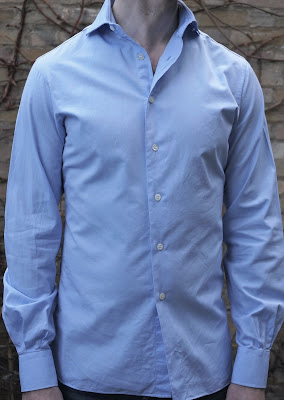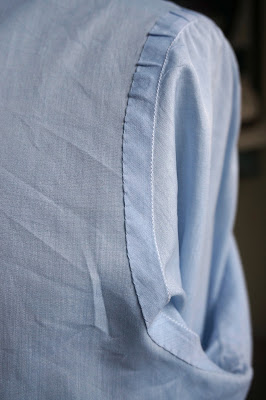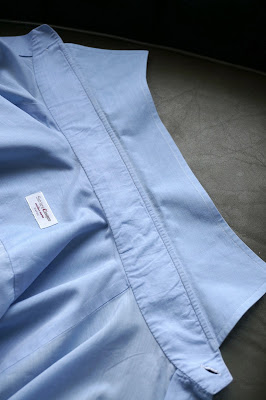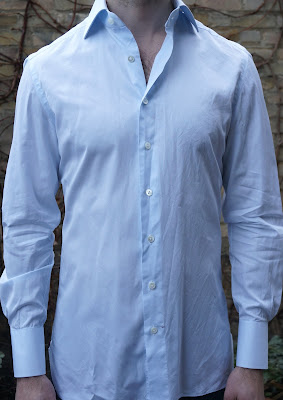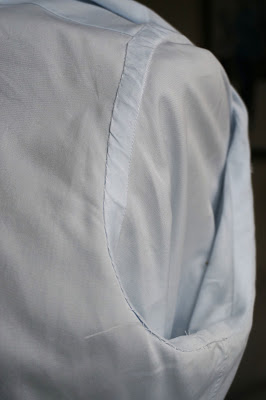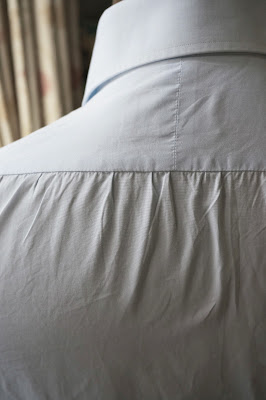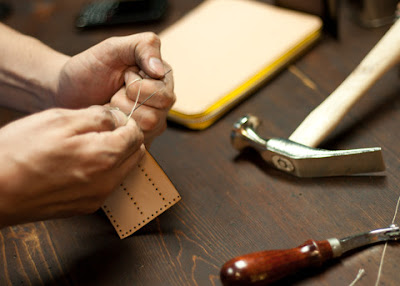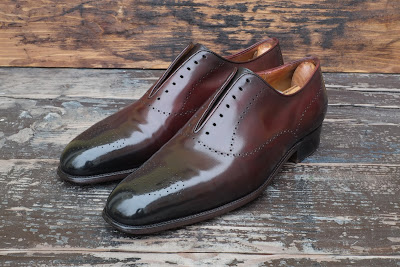Read it here.
↧
Latest piece on How to Spend It
↧
Dandy pieces in RISD Museum exhibition
Beginning in April, the Museum of the Rhode Island School of Design in the US will be holding an exhibition of clothing drawn from its archives and borrowed from sources around the world – including our own, inimitable Guy Hills and customers of cutter Kathryn Sargent.
I’ve picked out a few interesting pieces from the archives – more contemporary pieces readers will be familiar with.
This bespoke suit (above and top) was made for actor and writer Michael Strange (pseudonym of Blanche Oelrichs). Already breaking the mould when she was married to John Barrymore, Strange described the pleasure the couple enjoyed in swapping details of men’s and women’s clothing: “Jack and I dressed in a manner never affected before or since. Pleatings and flutings appeared on his trousers, duplications of the ones on my skirt. … He considerably lowered his shirt collars, of which I instantly had a dozen copies made.” Strange wore this suit by Brooks Uniform Company in her everyday life and when playing the title role of Napoleon II in L’Aiglon. The suit’s traditional construction is offset by a silk organdy dickie and trompe l’oeil bow tie.
This coat is one of few surviving garments from the age of Beau Brummell’s Regency London. A wool greatcoat from London tailor John Weston, who made for Brummell and George IV, it was deposited in the vaults of Coutts Bank and thus survived over 100 years in pristine condition.
An unlined suit worn by WF Whitehouse around 1910 and made by Hoar & Co of Bombay out of a double-cloth cotton. A dandy-explorer, Whitehouse dressed in a manner that constantly reminded people of his adventures to foreign territories. He was a pioneer of free hot-air ballooning and on one trip reached Bombay, where he likely celebrated with the commissioning of this jacket.
And a rather exotic banyan worn by George IV when Prince of Wales in the 1780s. A banyan is a quilted and printed robe, cut loosely and used in the same way as a house coat or dressing gown. Worn in parts of India and the Middle East.
And a rather exotic banyan worn by George IV when Prince of Wales in the 1780s. A banyan is a quilted and printed robe, cut loosely and used in the same way as a house coat or dressing gown. Worn in parts of India and the Middle East.
Also:
Shirts made by T Hodgkinson, a London maker, for Francis Carolan around 1900. In silk and cotton
Pantaloons worn by Edward Carrington around 1820, in wool broadcloth with brass buttons
↧
↧
Reader question: How to wear a bow tie
Hi Simon,
I hope you don't mind me seeking your counsel on the matter of bow ties. Previously, I have been somewhat dismissive of them and, indeed, those that wear them, perhaps. But for whatever reason, this is no longer the case.
I'm not sure if I'm getting this entirely right, but since the autumn (when I bought a couple from the excellent and helpful Peckham Rye on Newburgh St) I've enjoyed wearing a bow tie in the day.
The 'look' (in my 41 y-o mind, at least) is kind of a preppy-style - say, a bespoke brown herringbone sports jacket, sky-blue bow-tie with a small spot, white tab-collar shirt, fine wool knitwear (Italian-manufactured sleeveless cardigan), grey flannels and an ox-blood oxford.
I'm planning on increasing the number of days on which I will wear a 'b-t' this summer (especially at summer racing festivals - Newmarket's July Festival, Glorious Goodwood) and therefore want to check a couple of details.
What is the best collar (tab or spread or other) for a bow tie? Are there any faux-pas or pitfalls that one should be conscious of?
Thank you for your anticipated help with this matter – and congratulations on your excellent blog.
Best wishes for 2013,
Anthony R
Hi Anthony,
Thanks for your question, and I applaud your bolder wearing of a bow tie. Rather like a good hat, or braces, it is something that immediately sets the wearer apart and takes courage to wear. I don’t wear a bow very often, and I never wear braces, but I know it takes time to reach the conclusion that any item is not for you, and most that dismiss them do so out of fear.
From a style point of view, the key is to recognise that the bow tie has associations of fustiness (at least among most here in the UK) and to balance that with youthful touches elsewhere. Bright colours dotted around the outfit, for example, can suggest the Ivy swagger you are looking for. This is particularly important when worn with items like a brown herringbone jacket and cardigan.
On the casual side, I have a cashmere navy bow that I like to wear with an Oxford shirt, my Full Count jeans and suede shoes. A silk bow can also work well with V-neck knitwear, the texture of the wool providing a nice contrast in the same way as a tweed jacket. Also, given that most V-necks these days are cut very high, they look much better with a bow than a regular tie.
Which moves us on to practical points. The amount of shirting below the bow should be minimised, whether with knitwear, a waistcoat or a high-buttoning jacket. Double breasteds also work well for that reason. And keep any jacket closed when standing.
As to shirt collar, the thing to remember is balance. Both extreme cutaways and long points can look unbalanced. The best is a mid-cutaway that frames the bow without too much point below. Keep the size of the collar and the bow in equilibrium, adjusting the former depending on how you like to wear the latter. I also don’t mind button downs with bows, as they fit well into that preppy vibe you are looking to channel.
I hope that’s helpful. Good luck.
↧
Interview: Roubi L'Roubi, Huntsman
Last month Roubi L'Roubi and his partner Pierre Lagrange bought Huntsman. Roubi is a couturier who cuts and makes clothes for men and women. Perhaps understandably, there were fears that he intended to turnHuntsman towards womenswear, ready to wear or fashion. Last week I sat down with Roubi to ask him about his plans.
How have things been since the purchase was announced?
It’s great, friends keep dropping in and wanting to look around. They are fascinated by the tailoring and the work rooms – so few people realise that suits are still made that way. Huntsman has such a strong brand, particularly in the US, but there’s a job to do to communicate the work and the value of bespoke.
When did you first become aware of Huntsman?
During an open house a few years ago. I had already worked with other people on Savile Row, such as Henry Poole for which I designed a womenswear collection, but I didn’t know Huntsman very well.
I think most men associate ‘collections’ with ready to wear. But you work in couture, where everything in a collection is made bespoke for each customer.
Exactly, and that’s important to get across. So I am working on a collection at the moment for Huntsman, and there may be some elements of ready to wear, but it is mostly meant to inspire men to have different things made bespoke.
Which is what you do already from your studio on Bond Street?
Yes. We make for both men and women. I have always made for men my entire career. Couples often come in together, and I make dresses for women, suits for men. That happens a lot around racing events like Ascot, for example. And over the years I’ve made men’s pieces for the clergy at St Paul’s Cathedral, for conductors, singers and actors.
But will you be introducing more womenswear to Huntsman?
No, not at the moment. I’m working on a men’s collection and there are no immediate plans for womenswear. There are a few women’s busts around the shop with new pieces on, some of which are mine, but they were always there.
What will the menswear collection include?
It will be hunting clothing – something I have an affinity for because I both ride and shoot. There will be jackets with action backs, breeches and shooting vests. I’m a big fan of a shooting vest: it is cut the same as a jacket, just without the arms, and gives you the most range of movement. I wear one to shoot usually, over knitwear.
Vests and breeches might be available ready to wear, because sometimes a customer could come in and need something for that weekend. Not everyone has shooting clothing already, and invitations aren’t always sent out with enough time to have something made bespoke. [Pictures below are from Roubi's current collection.]
Are there any bespoke cutting techniques that you will work into the collection?
There are a few, yes. For example the action back on a shooting jacket is normally cut with the pleat close to the top of the sleeve. I find that it works better if the pleats are a couple of inches closer to the centre seam. Having them more central means there is less bulk around the shoulders, but they function just as well.
On the ready to wear suits, I find that there is normally excess cloth gathering under the collar at the back, because they are cut for someone that stoops a little bit. Obviously the angle won’t be perfect for everyone – you have to set it where you think the average is – but I think it’s a little too stooped at the moment.
The sleeves could also be a little longer. They are all unfinished, so they can be shortened to any length, and I think they should start longer. A surprising number of people have long arms. We should have the option of flat-fronted trousers too.
Will you be working on Savile Row now?
Yes, though probably downstairs. I like to be close to the tailors. There’s so much that depends on that close communication.
But you will carry on cutting women’s couture too?
Yes, although it will all be made at our Bond Street studio. The differences between cutting men’s and women’s are interesting. Heavy cloths often don’t work as well with women because you can’t put the curves in it. No heavy tweeds, no chalk stripes.
It will be interesting to see customers respond to seeing more examples of menswear pieces around the shop. And hopefully you will bring some genuinely new ideas. We wish you luck.
Thank you
It will be interesting to see customers respond to seeing more examples of menswear pieces around the shop. And hopefully you will bring some genuinely new ideas. We wish you luck.
Thank you
↧
Blue shirts: Burgos, Satriano Cinque, Segun Adelaja
This week is blue-shirt week. Over the next three days I will post about three blue shirts made for me in recent months, by three different makers. Hopefully running the three together will make for some interesting comparisons.
They are all identical in style – spread collar, single cuff, placket-less front. Little things like the shape of the collar stand, however, lead to some surprising differences. And the levels of hand work vary substantially. Whether that matters to you is something I’ll be interested in hearing comments on.
On the other hand, I would suggest not spending too much time analysing the fit of the shirts. As anyone who has tried photographing himself in a suit will know, the 2D result usually reflects little of how the 3D piece actually fits. I realise they are needed for the sake of perspective, but I recommend giving little weight to them.
The shirts were made by Burgos of Madrid, Satriano Cinque of Naples and Segun Adelaja of London (top to bottom, above). All were my first shirts, the first two bespoke and the third made to measure. This may seem like a slightly unfair comparison, but given Adelaja’s MTM price (£240 and up) they deserve to be compared together.
We start, tomorrow, with Burgos.
↧
↧
Burgos of Madrid: Bespoke shirt review
This bespoke shirt was made for me at the end of last year by Burgos in Madrid. Burgos is one of the oldest and most famous shirtmakers in Spain, and one of very few still making by hand and using old-fashioned techniques. For more background on Burgos, see my piece on my visit to the shop.
Burgos does not normally do fittings or trial shirts, unlike most other bespoke makers. Italian makers, certainly those in Naples, tend to make a shirt with one arm and a temporary collar for a fitting. English makers usually create a trial shirt, with its cost made up for by a minimum order of 3-6 shirts.
After having my measurements taken in Madrid, therefore, I received the finished shirt four weeks later in London. The fit, particularly the balance between the front and rear of the shirt, was good. Often shirtmakers cut the front of the shirt too large. Making it smaller can create a slimmer silhouette, with the bulk of the shirt in the back still allowing plenty of movement.
Still, I would have preferred it slightly neater in the waist, and the collar wasn’t what I had asked for. We were going to experiment with a pointed collar that had a button underneath the point – sometimes known as a ‘button under’. What arrived was a simple point collar without the button.
Carmen at Burgos was happy, indeed eager, to make the shirt perfect and she took it back, changing the collar (to the spread shown above) and narrowing the waist. It’s worth mentioning that Carmen is from the Burgos family but only recently joined the company, giving up a career in software. I’m sure this is a reason she is more professional than many other shirtmakers.
The second shirt I received was pretty much perfect. All the details were right, the fit was great and the hand work was exquisite. There are a few things I would change slightly, such as the height of the collar at the front, the thickness of the interlining and the material itself, but these are all easy to do. Of the three makers I will review this week, Burgos is the one with the most flexibility. They do fused and floating, in different weights, and with any level of hand work.
The following things were sewn by hand on my shirt: the sleevehead, the bottom edge, the buttonholes, the buttons and the collar. The most of the three shirts reviewed this week. The machine stitching was a tiny bit bigger though.
Other interesting differences included the shape of the bottom edges of the front and back of the shirt, with the latter having a square shape but the former rounded (see picture above). The collar buttonhole was also surprisingly high on the collar, and small, and there was no gap for the tie between the two sides of the collar.
Also, you can see from the photo below that the collar stand is cut straight but tapers towards the front – more than either of the other makers, which would explain why I felt the collar could be higher at the front.
Finally, I requested a slightly unusual placing of my initials, vertically on the front of the shirt, and I think it’s fair to say that could have been straighter.
Overall, an extremely well-made and well-cut shirt with a few niggling details that could be sorted out on a repeat order.
Ratings
Cut: 9 (on first shirt, 8)
Make: 9
Style: 7
Finishing: 8
Carmen will be visiting London on 15-16 March and New York on 11-13 of April, both with Lopez Herbon, tailor to the Spanish king. Contact camiseriaburgos@gmail.com.
Shirts start at €255.
↧
Satriano Cinque: Bespoke shirt review
The second post in this series on bespoke shirts looks at Satriano Cinque, the Neapolitan maker that was set up by Gabriella de l’Ero a few years ago.
Luca is the men’s cutter, and it is he who cut this shirt. You can see detailed pictures of his work here and shots of the two fittings we did on the shirt here.
The first thing you notice about the shirt, in common with all those I have had made in Naples, is its weight. It is incredibly light, which is partly due to the cloth but also the extremely thin fusing in the collar and cuffs. The seams, at the sleevehead for example, are also that much wider, which makes it less rigid. The whole thing bundles up into a mere handful of cotton.
To be honest, the cloth is too light for most of the year in England. It also creases more than heavier cottons. But we will make some more in different cloths next time around. (There will definitely be a next time.)
The hand work sits half way between English shirts, which typically have no hand stitching at all, and makers like Burgos of Madrid or other Neapolitan makers like Kiton. The functional things are done by hand – attaching collar band and sleeve – as well as aesthetic details like buttonholes and attaching buttons. But the bottom edge and the cuff are done by machine.
This is reflected in the price, with shirts starting at €180. The only problem is you have to go to Naples, at least twice. We are trying to arrange a series of visits to London, however, to tie in with tailor Solito (for whom Satriano makes the shirts).
The fit of the Satriano shirt was good. Not perfect, and not that much better than Burgos despite two fittings. (Though Burgos effectively had one fitting, given I sent it back to be changed once.) For the next order I will have the waist taken in by around an inch. Interestingly, Satriano uses darts in the back where none of the other makers reviewed this week do.
One of the most notable differences with Satriano was the shape of the collar band. It noticeably widens around the side of the neck, before narrowing again at the front. The effect of this is to make the collar stand up much more when not fastened. It sits happily under a jacket or crewneck sweater – indeed, it’s the only (non-buttondown) shirt that sits happily under my Anderson & Sheppard jackets, which have a larger and tighter collar than those of any other tailor.
Other differences: the third button sits a little low, exposing more of the chest when worn without a tie (I may have this raised a touch); there is a bigger tie gap than Burgos, but less than Segun Adelaja (review tomorrow); the initials were straighter than Burgos, but not on the bottom edge as I requested (again, this will be changed next time).
Overall, my favourite shirt so far, with exactly the right balance of hand stitching and machine for my money. Presuming the tweaks work out with the next order, this is likely to be my shirt of choice from now on.
Ratings:
Cut: 8
Make: 8
Style: 9
Finishing: 9
↧
Segun Adelaja: made-to-measure shirt review
The third in this series on bespoke shirts, this post looks at the made-to-measure service offered by Segun Adelaja, who owns a boutique in the Prince’s Arcade.
It is obviously not a direct comparison to either Burgos or Satriano Cinque, as it is not bespoke and not cut by hand. However, as the price is £240 for a shirt, it is actually more expensive, reflecting the costs of having a shop in London and the cost savings of not having to travel abroad.
It is also representative of the kind of service offered MTM by many tailors and shops in London and New York, and therefore an everyday alternative for many making the decision over where to have their shirts made.
As with most Italian MTM operations, there is a big range of choices in collar and cuff. I went for a spread collar with a large tie gap. That tie gap led to a greater arch of the tie than either Burgos or Satriano, though it was also aided by a stiffer interlining. If I were to order again I would reduce this; it was noticeably stiff in the conically shaped cuff.
The fit was impressively good for MTM. Little things were off like the balance of front to back, but MTM is never going to be able to correct this. It deserved comparison with both Burgos and Satriano on fit, even though both had direct contact with me and at least two goes at getting it right. That speaks well of Segun, rather than the Italian manufacturer he uses.
With regards to make, the following things were done by hand: the buttons, the buttonholes and the sleevehead (although you can see from the picture that the latter is coming a little loose already). Less than the other two reviewed shirts, therefore, though it was made well overall.
Distinctive aspects of the make are the pleating across the back, which Segun specifically requests and describes as his signature; the red gusset reinforcement; and the red stop-tack by the bottom button. The collar band, though not shown, is wide but narrows conventionally towards the front.
Overall, a very good made-to-measure shirt, if a little expensive. I would change the weight of the collar and cuff lining, as well as the cuff style, in another order. And always go for bespoke if it was easy, as it will be now with Satriano.
Ratings:
↧
What are your priorities with shirts?
It seems like everyone has found the three reviews this week very interesting.
If you don't mind, I'd also like to hear what you think about three things:
If you don't mind, I'd also like to hear what you think about three things:
- The value of aesthetic hand stitching (buttonholes or attaching buttons, which have little functional purpose) - the English and Italians are very different here;
- The importance of a well-fitting shirt compared to a jacket, given that if you value your tailoring the shirt will rarely be seen; and
- How much you think it is worth spending on shirts compared to suits and shoes - the same as shoes in a yearly budget, for example, or less?
Please comment as per usual in the boxes below, and feel free to add your experiences of any particular shirt makers.
Thanks for your thoughts.
↧
↧
James Weir: Style and the tailor
I first met James two years ago while following the making of my DB Prince of Wales suit at Henry Poole. (You can see that full series here.) As with most the Row’s apprentices, he has a passion for clothing that extends far beyond his day-to-day work, which of course is what this series of posts is intended to highlight. It’s also what makes me optimistic about the future of the bespoke tailoring.
Where do you work, doing what, and how long have you been there?
I’m currently an apprentice coat maker at Henry Poole & Co. I’ve been there for two and a half years.
How did you get into bespoke?
At school I studied fine art, textiles, history and drama. I have always been interested in fashion and ‘making’ – always making!
My family is steeped in the textiles industry in Ireland, producing linen, hence the originally Scottish surname 'Weir' from my father's side, which referred to the water used to power their small linen mill. My mother’s family was also involved in fashion/couture and on my grandfather's side fine textiles in northern Italy.
I knew that I wanted to be a tailor from my early teens. I’ve always been fascinated generally by construction of anything that fits the body, and I altered my own clothes when I was at school to my own style and fitting. After finishing A-Levels I came to London and walked into Henry Poole & Co. I had previously been to London doing research for my A-Levels and several times walked down Savile Row, but never gone in to any of the companies there. That day I was given an informal interview – I suppose they liked the look of me and what they hoped I had to offer. Events progressed quickly and I was working at Henry Poole & Co as an apprentice just a few weeks later.
What do you like about Savile Row?
I am interested in the history, the making of bespoke garments and the Row’s place in the context of tailoring. I think that Savile Row is about continuity and tradition and this is an important part of what it stands for.
I also like the idea that it’s a place men – and nowadays women – can come to have something of incredible craftsmanship made exactly for them. It’s a place you can have a one to one, and men especially don’t have this service as much as women do. I think that’s why a lot of men like to have a garment made for them, and Savile Row allows this to happen. I also enjoy working with the finest cloth and learning from the incredible skills the tailors, cutters and finishers have; it’s a great honour.
Describe your style, in terms of cut, cloth and colour.
I like clean cut, pared down garments, with little touches and embellishments of things such as silk and touches of the eccentric.
What’s your favourite style of suit?
I love three-button coats. There’s something terribly old fashioned about them.
What’s your favourite cloth and why?
I'd say traditional modern tweeds, such as Donegal and Yorkshire tweeds. I love outrageous Scottish tartans for their garishness, and herringbone tweeds and twills. The slubbier the better. It might sound clichéd but I like a modern twist on traditional cloth.
Silk is somthing I collect, but that’s a whole different ball game.
What’s your favourite piece of tailoring that you own?
Last year I made myself a three-piece Donegal tweed suit. Although I live in London my home is in Derbyshire in the Peak District and I love wearing it! For me cloths are meant to be worn and I like cloths which age in time; it's what I would call the life of clothing.
What’s your favourite accessory?
Ties and bow ties, made from silk, cotton or wool, depending on the season. Texture is crucial.
What do you wear at the weekend?
Jeans and John Smedley fine merino knits. Also my Donegal if I feel like it.
What designer brands do you like?
Good quality vintage men’s stuff. I am also a huge fan of John Smedley as its part of Derbyshire and I’ve been wearing it for years. Then Tom Ford, Ozzie Clarke …
What blogs or websites do you go on?
I don’t really follow fashion blogs, but do I read lots of books, flick through magazines and watch people around me.
↧
Chester Mox hand-sewn wallets
A reader commented recently that it would be nice to feature a few things on the blog that were more affordable. Well one thing that is certainly affordable for most men is a good wallet – and given that he will use it many times a day, it represents a good return on investment.
There are only a few quality aspects worth considering with leather goods: the type of leather, the type of stitching and (to a lesser extent) the finishing of the edges.
Leather can be a matter of personal taste, but stitching is always better by hand, as the saddle stitch is stronger than anything that can be done by machine.
Leather can be a matter of personal taste, but stitching is always better by hand, as the saddle stitch is stronger than anything that can be done by machine.
A small, family-owned company, it makes everything by hand and to order. It’s worth using your imagination when looking through the range of products on the website, therefore, and the excellent blogis another good source of inspiration.
I trialled one at the end of last year and it has done very well. It will particularly suit those that like more casual accessories, given the thicker Horween leathers used most widely by the company. Recent additions to the range include Horween’s Essex – a calf leather put through the cordovan tanning liquors – and Ilcea antique calf (below; some readers may recognise it).
↧
Jacket and trouser colours, Rubinacci
The second part of the feature that the Spanish version of How to Spend It ran on me and Luca Rubinacci has just come out. In the article, Luca picks out three Rubinacci outfits that display his unique take on colour and texture - reproduced here.
I wouldn’t wear any of them as a whole but, as I explained in my Pinterest post, that doesn’t mean there aren’t things to take away from each one.
In the top combination, for example, I love the dark red chinos with the glen check jacket – though the knit tie that echoes without replicating the trousers is needed to pull it together. I’d wear brown, not blue slip-ons.
I’m sensing a theme here. Again, it’s the combination of pale blue chinos and purple linen jacket. Knit tie helps anchor the two. I seem to wear grey flannels or jeans so much these days with jackets that it’s nice to have different suggestions.
Love the colour of the suit. I’d tone down everything else, and have dark brown buttons, but as a summer colour that wool is beautiful. Note the broad waistband with double-button closure that Rubinacci now does as standard. Also, the Rubinacci hanks that go so well with every outfit, due to their variety of colour and softness in cream, orange and blue.
Fuera de Serie piece on me here.
↧
Repatination from Dandy Shoe Care
While at Pitti Uomo in January, I met up with Alexander Nurulaeff, the very large, very friendly Russian behind Dandy Shoe Care. I’ve admired his patination work from afar for quite a while, but this was an opportunity to have him try out his technique on a pair of my shoes.
I gave him a pair of JM Westons, cherry-red whole cuts that are around five years old. They had some signs of wear, as you see on the pictures of the toes below, but were generally in decent shape.
What I really wanted was for Alexander to alter the colour. I have two pairs of red shoes, including these, but I find I rarely wear them. They work well with a navy suit, white shirt and dark tie, but rarely persuade me to shape an entire outfit around them.
I therefore asked that they be darkened, specifically to mimic the dark-brown ‘Mark’ patina he shows on his site.
The result, received in the post a couple of weeks later, was extremely impressive. I have seen repatination done very badly, with the results cracking across the vamp of the shoe or simply chipping off after a few weeks of use.
There were no such problems here. The finish was smooth, has lasted very well and after one or two coats of cream it looks as if the shoes were always that colour. I also had an Hermes belt painted a dark, variegated brown and that turned out very well (pictures some other time).
The only point of criticism would be that the finish wasn’t quite the ‘Mark’ I had requested. It was more black than brown and faded to red rather quickly towards the mid-section. Alexander explained that the brown wasn’t quite possible, given the colour of the shoes – fine, but could perhaps have been communicated earlier – and the fading was something it was hard to specify exactly – I agree, though I would try to be more specific next time.
Overall, a beautiful piece of work. Only Berluti has matched Alexander’s work in my experience (see my Berluti repatinationhere).
Photo of Alexander: Luke Carby
Photo of Alexander: Luke Carby
↧
↧
Celebration time: Permanent Style tops 300,000 visitors
In January, for the first time in our history, there were over 300,000 visits to the Permanent Style site, doubtless helped by Pitti, The Times and Fuera de Serie.
Thank you so much to everyone that visits, reads and contributes to the ongoing work of this site. I'm so glad you find it interesting and useful, and share the same aims of quality, investment and classic style.
Photo by Luke Carby, from the upcoming feature on Richard Anderson in The Rake. Tux by Richard in a black house mohair/wool mix cloth; voile and marcella shirt by Sean O'Flynn with detachable stiff collar; and bow tie in matching grosgrain by Drake's.
↧
Satriano Cinque and Solito in London
As promised in my recent posts on Neapolitan shirtmaker Satriano Cinque, they and bespoke tailor Solito will be in London next month. The dates are April 19 and 20, although only in the afternoon of the 19th. Luigi Solito already visits London often, but Luca from Satriano is now planning to come regularly too, which is great news.
For information on Satriano, see post hereand review here. You'll find one post on Solito here, and I will post a piece on my bespoke jacket from them before Luigi gets here.
The guys will be at the Holland & Sherry showroom on Savile Row, and I recommend booking with Luca in particular as early as possible - I know he already has several appointments. The best contact is Luca's email, g.delero@libero.it, or the mobile numbers on the invite above.
Hopefully see some of you there.
↧
Anderson & Sheppard on Clifford Street: It’s cheap!
It is perhaps understandable to assume that the new Anderson & Sheppard store on Clifford Street is expensive. Bespoke suits round the corner certainly aren’t cheap, while in Clifford Street the trousers are over £300 and you can pay £900 for a fur hat.
But the pricing is actually very reasonable, in my view (much like the bespoke suits). This is best illustrated by the cheaper items available: cotton handkerchiefs for £15, wool ties for £40, Shetland sweaters for £140 and lambswool cable knits for £140.
“We’re encouraging people to wear wool,” says Audie, who manages the shop and is always wonderfully stylish herself. “It has many advantages of cashmere, not least the price.”
The Clifford Street boutique is quickly becoming my favourite shop in London. I particularly recommend the wool/silk neckerchiefs as seen above (so much more modern than silk at the neck of a sweater or shirt) and the Shetland knitwear below, for its wonderful variety in colour and neat fit (size down and the fit is pretty slim, without the body or arms shortening too much).
For all those that care, I stopped working for Anderson & Sheppard last month, handing the Notebook over to staff internally. This is the objective opinion of a passionate customer.
↧
Why most tailors don’t like clothes
Quite a lot of tailors and cutters don’t wear jackets, even waistcoats during the day. Certainly if they are hidden away from the eyes of customers, they quickly dress down. Partly this is because such work is difficult to perform all day in anything but a shirt, no matter how well (or drapey) the jacket. But also the attitude of most tailors to their clothes has always been different to that of their customers. They are craftsmen, not artists; builders, not architects (please suggest additional metaphors).
“For me, the greatest pleasure in tailoring is when you put a jacket on a customer and see his reaction. When you’ve absolutely nail it, and you see in his face that he knows it,” says Russell Howarth of Graham Browne. “You’re not cutting for yourself.”
This was Russell’s opinion in a recent conversation, and several others echo it. The follow-up, though, is perhaps more interesting. “If a tailor wears his own tailoring, he will constantly be finding fault with it. No matter how small, even if it’s just the placement or the length of a single stitch.
“If he’s honest, no cutter is ever 100% satisfied with something he’s wearing. There’s always a tiny thing about he would change,” Russell concludes.
Many tailors, particularly cutters, dress very well, and there have been some real dandies on Savile Row over the years. But the point seems to hold true. Perhaps one of the reasons it’s such a pleasure to dress a client and then get him out the door is that you’re never close enough to the suit again to find the things you would change. The creation remains at arm’s length, like a painting removed from the easel and hung above the mantelpiece.
Image: Craig Featherstone at work at Henry Poole
Image: Craig Featherstone at work at Henry Poole
↧
↧
How to buy a good leather bag
The latest in my series in How to Spend It is live. This month we look at how to buy a good leather bag, including assessing the leather, the difference between types of hardware and spotting hand stitching.
It includes interviews with Bill Amberg, Max Summerskill of Dunhill and Carol Bellingham of William & Son, and features bags by J Panther Luggage and Vitale Barberis.
Click here for the full feature, How to buy... a leather bag.
Pictured: rocket bag by Bill Amberg.
↧
Sean O'Flynn bespoke dress shirt
At the end of last year I completed a project with Sean O’Flynn to cut a traditional dress shirt, with voile back, Marcella front and detachable stiff collar. Some readers may remember they have already seen this shirt in black tie shoots with The Rake. I can only apologise it’s taken this long to write up the details.
While I have written recently of seeking a Neapolitan shirtmaker to eventually replace my whole shirt wardrobe (with Satriano Cinque the front runner), for a formal shirt like this the twin draws of tradition and proximity drew me to Sean.
Sean’s pedigree is unrivalled, having started his career with an apprenticeship at Huntsman at the age of 16 and gone on to be the head cutter at New and Lingwood. He started his own business in 2005 and is now one of only a handful of bespoke shirtmakers in London, cutting everything by hand on the premises.
The shirt we made was a slight deviation from the norm, with a very lightweight voile back and heavy Marcella front. Normally the back wouldn’t be quite as light, for fear of pulling away from the more structured front, but seeing as the shirt will get light wear and be washed carefully, I was comfortable with the risk.
We opted for two detachable collars in the end, a stiff wing collar (they’re very stiff) and a turn-down Marcella one. The former will go best with my Richard Anderson tux, perhaps, and the latter with the Timothy Everest velvet jacket.
English shirtmakers don’t normally do a fitting, unlike their European peers, instead making a trial shirt that should then be perfected on the next shirt (hence the minimum orders some makers require). Sean was pretty confident he could get the fit first time, however, and he was pretty much good to his word (despite the reports of some readers). The only point that was a little too tight was around the hips, which is hardly the worst place for the fit to be off. Elsewhere it was perfect.
The stiff collar takes some getting used to, but does show off a good bow tie to its full potential. In the case of the Rake shoot that bow was a specially commissioned one piece from Le Noued Papillon. The stiff collar could be seen as the crowning glory to a good tuxedo.
The stiff collar takes some getting used to, but does show off a good bow tie to its full potential. In the case of the Rake shoot that bow was a specially commissioned one piece from Le Noued Papillon. The stiff collar could be seen as the crowning glory to a good tuxedo.
The shirt has been worn, washed and reworn and performed very well. I might change the lightness of the voile, but that is purely because the wool/mohair exclusive Richard Anderson cloth is so light that any step outside at an evening event induces chills. It contains no hand sewing, unlike the European makers we have discussed, but that hardly seems a priority.
Sean charges£241 for a standard shirt and £278 for a dress shirt such as this (both including VAT).
↧
Why sartorialists should love John Smedley
Of the tailors I have interviewed recently in my Style and the Tailor series, several have mentioned that they wear John Smedley knitwear at the weekend. There is a reason for this.
Smedley rightly calls itself ‘tailored’ knitwear. It is fully fashioned, rather than being made of pieces that are cut and sewn together, which creates a much smoother and more ergonomic fit. You can see that in the shoulder seam of Smedley knits: its backward-sloping angle can only be achieved on fully fashioned knitwear, and it vastly improves the fit. Most tailoring, particularly that which prioritises comfort (such as Anderson & Sheppard) has a similar seam.
Classic items like the Dorset long-sleeved polo shirt have a much higher collar, making them suitable to wear under a jacket. Most polo-shirt collars are too small, and disappear under the jacket’s collar. Not a flattering look. The Dorset also has a turn-back cuff, which is much dressier, and like much of the Smedley collection is woven in 24-gauge merino wool, making it easily light enough to wear under tailoring.
Much high-end knitwear is fully fashioned. But it doesn’t have these additional, dressy aspects, and it isn’t all made in the UK by a company that’s been making the same way for 230 years. Plus I don’t know anyone (other than Tom Ford) that makes fully fashioned cotton polo shirts.
Perhaps most importantly, the Classics collection doesn’t change. The body shape is the same across all the models – only the neckline varies. And since two years’ ago, nothing has been tweaked from season to season. That’s pretty rare these days.
More detail on Smedley models, including a feature on the factory, soon.
↧













